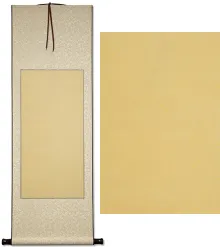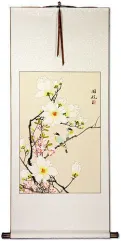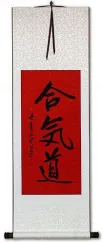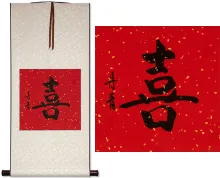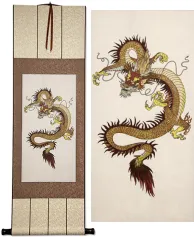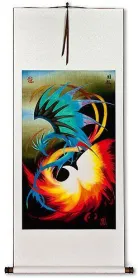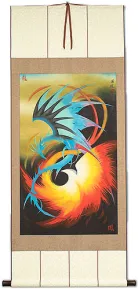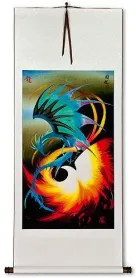Many custom options...
And formats...

White Dragon in Chinese / Japanese...
Buy a White Dragon calligraphy wall scroll here!
Personalize your custom “White Dragon” project by clicking the button next to your favorite “White Dragon” title below...
White Dragon
Southern Praying Mantis
南派螳螂 can be translated literally as “Southern School Praying Mantis” or “Southern Style Praying Mantis.”
Despite its name, the Southern Praying Mantis style of Chinese martial arts is unrelated to the Northern Praying Mantis style. Southern Praying Mantis is instead related most closely to fellow Hakka styles such as Dragon and more distantly to the Fujian family of styles that includes Fujian White Crane, Five Ancestors, and Wing Chun.
This style of martial arts focuses more on fighting skills rather than aesthetics.
Of course, you already knew that if you were looking for this term.
Note: This title can be pronounced and does have meaning in Korean but only to Koreans familiar with Chinese martial arts.
This in-stock artwork might be what you are looking for, and ships right away...
Gallery Price: $268.00
Your Price: $148.88
Gallery Price: $60.00
Your Price: $36.88
Gallery Price: $60.00
Your Price: $36.88
Gallery Price: $60.00
Your Price: $36.88
Gallery Price: $87.00
Your Price: $47.88
Gallery Price: $65.00
Your Price: $39.88
Gallery Price: $90.00
Your Price: $49.88
Not the results for white dragon that you were looking for?
Below are some entries from our dictionary that may match your white dragon search...
| Characters If shown, 2nd row is Simp. Chinese |
Pronunciation Romanization |
Simple Dictionary Definition |
白 see styles |
bái bai2 pai yuki ゆき |
More info & calligraphy: White(1) white; (2) (See ボラ・1) striped mullet fry (Mugil cephalus); (3) (See 科白・1) (spoken) line (in a play, film, etc.); one's lines; (4) {mahj} white dragon tile; (5) {mahj} winning hand with a pung (or kong) of white dragon tiles; (6) (abbreviation) (rare) (See 白耳義・ベルギー) Belgium; (7) (abbreviation) (archaism) (See 白人・1) white person; Caucasian; (female given name) Yuki White, pure, clear; make clear, inform. |
四象 see styles |
sì xiàng si4 xiang4 ssu hsiang shishou / shisho ししょう |
four divisions (of the twenty-eight constellations 二十八宿[er4 shi2 ba1 xiu4] of the sky into groups of seven mansions), namely: Azure Dragon 青龍|青龙[Qing1 long2], White Tiger 白虎[Bai2 hu3], Vermilion Bird 朱雀[Zhu1 que4], Black Tortoise 玄武[Xuan2 wu3] four images; four symbols; four emblems; four phenomena; four phases; (given name) Shishou |
文殊 see styles |
wén shū wen2 shu1 wen shu monju もんじゅ |
Manjushri, the Bodhisattva of keen awareness (Buddhist term) Manjushri; Manjusri; Bodhisattva that represents transcendent wisdom; (p,s,f) Monju (文殊師利) Mañjuśrī 滿殊尸利 -later 曼殊室利. 文殊 is also used for Mañjunātha, Mañjudeva, Mañjughoṣa, Mañjuṣvara, et al. T., hjamdpal; J., Monju. Origin unknown; presumably, like most Buddhas and bodhisattvas, an idealization of a particular quality, in his case of Wisdom. Mañju is beautiful, Śrī; good fortune, virtue, majesty, lord, an epithet of a god. Six definitions are obtained from various scriptures: 妙首 (or 頭 ) wonderful or beautiful) head; 普首 universal head; 濡首 glossy head (probably a transliteration); 敬首 revered head; 妙德 wonderful virtue (or power); 妙吉祥 wonderfully auspicious; the last is a later translation in the 西域記. As guardian of wisdom 智慧 he is often placed on Śākyamuni's left, with 普顯 on the right as guardian of law 理, the latter holding the Law, the former the wisdom or exposition of it; formerly they held the reverse positions. He is often represented with five curls or waves to his hair indicating the 五智 q. v. or the five peaks; his hand holds the sword of wisdom and he sits on a lion emblematic of its stern majesty: but he has other forms. He is represented as a youth, i. e. eternal youth. His present abode is given as east of the universe, known as 淸涼山 clear and cool mountain, or a region 寶住 precious abode, or Abode of Treasures, or 寶氏 from which he derives one of his titles, 寶相如來. One of his dhāraṇīs prophesies China as his post-nirvāṇa realm. In past incarnations he is described as being the parent of many Buddhas and as having assisted the Buddha into existence; his title was 龍種上佛 the supreme Buddha of the nāgas, also 大身佛 or 神仙佛; now his title is 歡喜藏摩尼寶精佛 The spiritual Buddha who joyfully cares for the jewel: and his future title is to be 普現佛 Buddha universally revealed. In the 序品 Introductory Chapter of the Lotus Sutra he is also described as the ninth predecessor or Buddha-ancestor of Śākyamuni. He is looked on as the chief of the Bodhisattvas and represents them, as the chief disciple of the Buddha, or as his son 法王子. Hīnayāna counts Śāriputra as the wisest of the disciples, Mahāyāna gives Mañjuśrī the chief place, hence he is also styled 覺母 mother, or begetter of understanding. He is shown riding on either a lion or a peacock, or sitting on a white lotus; often he holds a book, emblem of wisdom, or a blue lotus; in certain rooms of a monastery he is shown as a monk; and he appears in military array as defender of the faith. His signs, magic words, and so on, are found in various sutras. His most famous centre in China is Wu-tai shan in Shansi. where he is the object of pilgrimages, especially of Mongols. The legends about him are many. He takes the place in Buddhism of Viśvakarman as Vulcan, or architect, of the universe. He is one of the eight Dhyāni-bodhisattvas, and sometimes has the image of Akṣobhya in his crown. He was mentioned in China as early as the fourth century and in the Lotus Sutra he frequently appears, especially as the converter of the daughter of the Dragon-king of the Ocean. He has five messengers 五使者 and eight youths 八童子 attending on him. His hall in the Garbhadhātu maṇḍala is the seventh, in which his group numbers twenty-five. His position is northeast. There are numerous sutras and other works with his name as title, e. g. 文殊師利問菩提經 Gayaśīrṣa sūtra, tr. by Kumārajīva 384-417: and its 論 or .Tīkā of Vasubandhu, tr. by Bodhiruci 535. see list in B. N. |
白板 see styles |
bái bǎn bai2 ban3 pai pan shiraita しらいた |
whiteboard; tabula rasa; blank slate (1) {mahj} white dragon tile (chi: báibǎn); (2) (colloquialism) (kana only) shaved pubic area; person with little or no pubic hair; (place-name, surname) Shiraita |
白牌 see styles |
bái pái bai2 pai2 pai p`ai pai pai hakupai はくパイ |
(of a product) unbranded {mahj} (See 白板・パイパン・1) white dragon tile |
白竜 see styles |
hakuryuu / hakuryu はくりゅう |
white dragon; (given name) Hakuryū |
昇り竜 see styles |
noboriryuu / noboriryu のぼりりゅう |
(1) rising dragon; (2) (kana only) white saddle (Helvella crispa); elfin saddle; common helvel |
昇り龍 see styles |
noboriryuu / noboriryu のぼりりゅう |
(1) rising dragon; (2) (kana only) white saddle (Helvella crispa); elfin saddle; common helvel |
登り竜 see styles |
noboriryuu / noboriryu のぼりりゅう |
(1) rising dragon; (2) (kana only) white saddle (Helvella crispa); elfin saddle; common helvel |
登り龍 see styles |
noboriryuu / noboriryu のぼりりゅう |
(1) rising dragon; (2) (kana only) white saddle (Helvella crispa); elfin saddle; common helvel |
十三觀音 see styles |
shí sān guān yīn shi2 san1 guan1 yin1 shih san kuan yin |
(三十三尊觀音) The thirty-three forms in which Guanyin is represented: with willow, dragon, sutra, halo, as strolling, with white robe, as lotus-sleeping, with fishing-creel, as medicine-bestowing, with folded hands, holding a lotus, pouring water, etc. 三十三過 The thirty-three possible fallacies in the statement of a syllogism, nine in the proposition 宗 pratijñā, fourteen in the reason 因 hetu, and ten in the example 喩 udāharaṇa. |
Variations: |
hakuryou; hakuryuu / hakuryo; hakuryu はくりょう; はくりゅう |
white dragon |
ノボリリュウ see styles |
noboriryuu / noboriryu ノボリリュウ |
(1) rising dragon; (2) (kana only) white saddle (Helvella crispa); elfin saddle; common helvel |
Variations: |
noboriryuu; noboriryuu / noboriryu; noboriryu のぼりりゅう; ノボリリュウ |
(1) (See 昇竜・しょうりゅう) rising dragon; (2) (kana only) white saddle (Helvella crispa); elfin saddle; common helvel |
The following table may be helpful for those studying Chinese or Japanese...
| Title | Characters | Romaji (Romanized Japanese) | Various forms of Romanized Chinese | |
| White Dragon | 白龍 白龙 | bái lóng / bai2 long2 / bai long / bailong | pai lung / pailung | |
| Southern Praying Mantis | 南派螳螂 | nán pài táng láng nan2 pai4 tang2 lang2 nan pai tang lang nanpaitanglang | nan p`ai t`ang lang nanpaitanglang nan pai tang lang |
|
| In some entries above you will see that characters have different versions above and below a line. In these cases, the characters above the line are Traditional Chinese, while the ones below are Simplified Chinese. | ||||
Successful Chinese Character and Japanese Kanji calligraphy searches within the last few hours...




